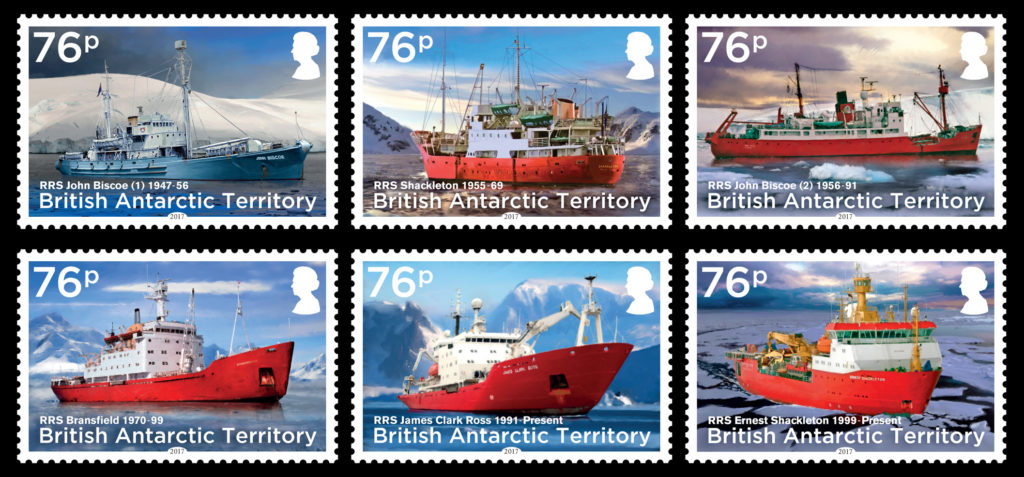
Ahead of the launch of one of the most advanced polar research vessels in the world – the RRS Sir David Attenborough – we released a stamp set looking back at past and present ships.
Find out where to buy our stamps
Ice-strengthened ships manned by experienced personnel have been a cornerstone of the UK’s Antarctic operations since 1943. Initially, the role of the ships was to establish bases and provide annual relief with staff, supplies and mail, but they also opened up otherwise inaccessible locations to scientific field parties. Ships officers have always carried out a variety of hydrographic survey and sea ice observation work to help with the demanding and at times dangerous task of navigating in icy and poorly charted waters.
During Operation Tabarin (1943-1945), ship support was provided by the Admiralty. Then, in 1947, the newly formed Falkland Islands Dependencies Survey (FIDS) purchased its first vessel. New polar vessels have been named either after previous polar ships or individuals associated with polar exploration. The first ship (the MV Pretext) was renamed the MV John Biscoe after the English 19th-century sea captain, John Biscoe (1794-1843).
The FIDS scientific work was recognised in 1953 by the granting of Royal Research Ship (RRS) status to FIDS (later British Antarctic Survey (BAS)), vessels. In 1955 a second ship was bought, the RRS Shackleton.
The RRS Shackleton was in service with FIDS/BAS from 1955/56 until 1968/69. Her role was primarily that of a survey and science vessel, supporting marine geophysics programmes. On 29 Nov 1957, having completed the relief of Base H, Signy Island, the vessel was north of Coronation Island, South Orkney Islands, when she collided with heavy pack ice and was holed in two places below the waterline. Number 2 hold filled with water but using the ship’s pumps and temporary repairs she was stabilised and, escorted by the whaling ship Southern Venturer and HMS Protector, put into Stromness Bay, South Georgia, for repair.
From 1969, the Shackleton was operated by BAS’s parent body, NERC (Natural Environment Research Council) as an oceanographic research vessel carrying out geophysical and marine geology cruises in Antarctic waters until being withdrawn from service in May 1983 and sold.
In 1956 the first purpose-built support vessel, RRS John Biscoe (2), replaced her ageing namesake. Her maiden voyage included HRH Prince Philip, the Duke of Edinburgh, visiting some of the FIDS research stations during the 1956/57 season.
Initially the RRS John Biscoe (2) operated as a cargo vessel to resupply FIDS (later BAS) research stations. Increasingly she supported hydrographic and marine biology surveys, and geological landings. Following a major refit in 1979, her role became that of a platform for marine science, particularly the Offshore Biology Programme. Modifications included replacement of the main engines, new laboratories, winches for sampling down to 3,000 metres, a gantry for trawling and bow thruster to enable the ship to maintain station in strong winds and currents. New instrumentation included a satellite navigation system, echo-sounder and echo-integrator and salinity-temperature-depth profiler. Her final voyage with BAS took place during the 1990/91 season.
The John Biscoe‘s motor launch, sometimes referred to as the ‘Biscoe Kid’, was transferred to the RRS James Clark Ross and continued to be used until around 2002. She later took part in the Queen’s Diamond Jubilee Thames Pageant on 3 Jun 2012.
Charter vessels continued to be used as required until 1970, when the newly built RRS Bransfield replaced the RRS Shackleton. The RRS Bransfield was an ice-strengthened cargo vessel, purpose-built for operation by BAS. The Bransfield was BAS’s main supply vessel from 1970/71-1998/99, and also had limited facilities for on-board research. She represented NERC in the Review of the Fleet at Spithead in 1977, held to celebrate Queen Elizabeth II’s Silver Jubilee.
She was named after Edward Bransfield, Royal Navy (1785-1852), a British Explorer who made significant discoveries around the Antarctic Peninsula.
In 1991 the RRS James Clark Ross (JCR) became the first BAS vessel to be purpose-built as a science platform. Launched by HM the Queen in 1990, she is primarily a marine research vessel for biological, oceanographic and geophysical cruises. She is equipped with a suite of laboratories and winch systems that allows scientific equipment to be deployed astern or amidships. The ship has an extremely low noise signature, allowing the deployment of sensitive acoustic equipment. A swath bathymetry system was fitted in 2000. The JCR also carries out some cargo and logistical work. During the northern summer the JCR supports NERC research, largely in the Arctic.
The RRS James Clark Ross was named after Admiral Sir James Clark Ross, R.N. The vessel can steam at a steady two knots through level sea ice one metre thick. To assist passage through heavy pack ice a compressed air system rolls the ship from side to side freeing the passage.
When RRS Bransfield was sold in 1999, logistical support was taken up by RRS Ernest Shackleton, operated by BAS on a long-term charter. Launched in 1995 the vessel is ice strengthened and capable of a wide range of logistic tasks as well as having a scientific capability. During the northern summer she is commercially chartered and usually works in the North Sea. As was her predecessor, the RRS Ernest Shackleton was named after the famed polar explorer.
In the future the functions of both current BAS ships (RRS James Clark Ross and the RRS Ernest Shackleton) will be combined in the new NERC polar research vessel, the RRS Sir David Attenborough, due for launch in late 2018.
Artworks based on photographs from the British Antarctic Survey Archives Service.
Technical details
| Artist | Andrew Robinson |
| Printer | Cartor Security Printing |
| Process | Lithography |
| Perforation | 13 ¼ x 13 ½ per 2cms |
| Stamp size | 42 x 28mm |
| Sheet Layout | 10 |
| Release date | 25 November 2017 |
| Production Co-ordination | Creative Direction (Worldwide) Ltd |
